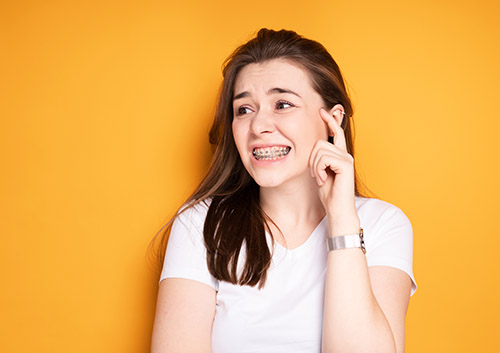Our Blog
What’s the Function of Functional Appliances?
March 22nd, 2023

Whenever we bite down, we’re applying force with our jaw muscles. Functional appliances direct these forces to create healthier tooth and jaw alignment. They’re used to help correct bite problems and to encourage symmetrical jaw growth.
Functional appliances aren’t always necessary. Because every child’s teeth and bite are different, orthodontic treatment at our St. George, UT, Lancaster or Tehachapi, CA office is carefully tailored to your child’s individual needs.
- For the child with minor tooth misalignment, traditional braces or aligners might be all that’s needed.
- For the child with a minor malocclusion, or bite problem, an orthodontist might use elastics (rubber bands) to bring teeth into healthy alignment.
- For the child who has a more serious malocclusion, involving both tooth and jaw alignment, an orthodontist might recommend a functional appliance.
A severe Class II malocclusion can be caused when the upper jaw or teeth are positioned too far forward, and/or the lower jaw is too small or positioned too far back. Common Class II malocclusions include:
- Open bite—the front teeth don’t touch when the back teeth bite down, or the back teeth don’t touch when the front teeth close.
- Overbite—some overbite is normal. A deep overbite occurs when the upper teeth significantly overlap the lower teeth.
- Overjet—the upper front teeth protrude further horizontally than they should.
Today’s functional appliances come in a variety of designs to treat Class II malocclusions. They can be fixed or removable. They can be used with or without braces. Some are designed to expand the upper palate to make sure there’s room for all the permanent teeth. What they all do is advance the position of the lower teeth and jaw to create a healthier, more comfortable bite.
Fixed devices are attached to the teeth and meant to be used full-time. These include the Forsus™ device, the Herbst® appliance, and the MARA appliance.
- Forsus Device
This appliance works with braces. A spring coil rod is most often attached to bands on the first molars on the upper jaw. It’s then connected to the arch wire on the lower jaw. Just like elastics—but more effective!—these spring coil rods provide gentle forward pressure that encourages the lower jaw and teeth forward.
- Herbst Appliance
The Herbst appliance also applies forward pressure to the lower jaw using telescoping rods connecting the upper and lower teeth. The rods expand as the mouth opens, and telescope together as it closes, positioning the lower jaw further forward while the upper jaw is held back. The Herbst can be worn alone or with braces, and can also be used to expand the upper palate.
- MARA Appliance
The MARA (Mandibular Anterior Repositioning Appliance) uses an adjustable “elbow” piece connecting bands on upper and lower molars to guide the lower jaw and teeth forward when the jaw closes.
Removable appliances such as Bionator and Twin Block appliances can also improve Class II malocclusions. They are meant to be worn for a specific number of hours each day, and can be taken out for sports or other activities as needed. Because it’s essential to get all the necessary hours in, removable appliances require commitment!
- Bionators
A bionator is made of wire and acrylic, and it looks a lot like a retainer. The wire fits around the upper front teeth. It’s attached to a smooth piece of acrylic that sits behind the upper teeth and is shaped to guide the lower jaw forward when biting down. The bionator can also be adjusted to expand the upper palate.
- Twin Block Appliance
The twin block appliance uses two separate pieces made of wire and smooth acrylic. Both pieces are modeled to fit precisely over the upper and lower arches. The acrylic “blocks” fit over the biting surfaces of the teeth, working together like a 3D puzzle. When your child bites down, the upper blocks slide into place behind the lower blocks, pushing the lower jaw and teeth forward. The top plate can also be adjusted to expand the upper palate if needed.
Because these appliances are best used while a child’s bones are still growing and developing, dentists and orthodontists recommend an orthodontic evaluation by age seven. Early treatment with a functional appliance can help correct serious bite problems before or together with braces. In some cases, functional appliances may reduce the need for headgear or surgery.
Todays’ orthodontic technology has made functional appliances more comfortable and efficient than ever before. Talk to Dr. Theurer to discover how an individualized treatment plan and a custom appliance can give your child a healthy bite and a lasting smile.
Tags:
Posted in Uncategorized | No Comments
Ouch! Are You Biting Your Cheeks More Often?
March 15th, 2023

You’re biting into something delicious, and, Ouch! You bite into something you didn’t mean to—the inside of your tender cheek.
Painful moments like this happen every now and again. But if you find that more frequent cheek biting means that you’re extra-cautious when eating or speaking, if you wake up with sore cheeks in the morning, or if you catch yourself gnawing on your cheeks during the day, it’s time to see Dr. Theurer.
Causes of Cheek Biting
Many of us experience the occasional cheek chomp when we’re eating or talking. No fun! Besides the pain, a bite can cause broken skin, inflammation, a canker sore, or a cyst. Luckily, the discomfort from these accidental bites generally resolves after a few days.
Sometimes, though, biting becomes a more frequent annoyance. Regular bites can be caused by several conditions. One of the most common?
- Orthodontic Misalignment
If you notice that you seem to be biting your cheek a lot when eating or speaking, it could be an orthodontic problem. When your teeth or jaws don’t align properly, if your mouth is small in proportion to your teeth, or if your teeth have shifted over time, your cheeks can feel the consequences! Dr. Theurer can help you discover if a misaligned bite is the source of your biting problems.
But it’s not just orthodontic problems which can cause painful cheek bites. Other causes can include:
- Bruxism
Bruxism is a medical term for tooth grinding. If you clench or grind your teeth as you sleep, it’s hard on your teeth and on your jaws. And for some people, that nightly gnashing causes cheek biting as well.
- Wisdom Teeth
Most of us don’t have the room to welcome four new—and large—teeth. As the wisdom teeth come in, they can cause bites, especially if they erupt leaning outward toward your cheeks. They can also push your other teeth out of place.
Treatment Options
Why visit our St. George, UT, Lancaster or Tehachapi, CA orthodontic office? A one-time bite can be extremely uncomfortable, and might lead to inflammation or a sore spot inside your mouth. Usually, these reactions fade in a short while.
But what about continuous biting? Regular biting injuries can lead to bigger problems. Tissue can get thicker or erode. Scar tissue can build up inside the mouth. Ulcers and other sores can become larger and more painful.
If you’ve been biting your cheeks more often, your orthodontist can diagnose the cause and offer you treatment options depending on the reason for this frequent biting:
- Orthodontic Treatment
Orthodontic treatment can improve tooth and bite alignment—and can eliminate those painful cheek bites if misalignment is what’s causing them. Today’s orthodontics offers more options than ever before, for both adults and kids.
- Traditional braces are more effective—and more subtle—than ever, with brackets which are smaller or come in clear and ceramic styles.
- Clear aligners are a convenient, almost invisible way to treat misalignment with a series of trays which gradually improve alignment with each new set.
- Lingual braces are attached to the back of the teeth, so there are no visible brackets and wires.
- Functional appliances can improve and correct bite issues which braces or aligners alone can’t treat as effectively.
Whatever the reason for painful cheek biting, you deserve to eat and speak and enjoy your day without constant “Ouch!” moments affecting your comfort and health. If these moments are happening all too often, visit our St. George, UT, Lancaster or Tehachapi, CA office for the answers to your biting problems.
Tags:
Posted in Uncategorized | No Comments
The Herbst® Appliance
March 8th, 2023

Maybe you’ve known people with braces and aligners—maybe you’ve worn them yourself!—so if braces or aligners are in your teen’s future, you have some idea what to expect and when to expect it.
But quite often, orthodontic issues require more treatment than braces alone can provide. When misalignment affects not only the teeth but the jaw as well, treatment can be more effective when it begins earlier and makes use of a different kind of appliance—the “functional appliance.”
During the years your child’s bones are still rapidly growing and forming, around the ages of eight to 14, functional appliances can help guide tooth movement and encourage jaw growth and development. One of the most widely used of these devices is the Herbst® appliance.
What does the Herbst appliance do?
There are several types of malocclusions, or “bad bites” treated by Dr. Theurer. A common condition called a Class II malocclusion occurs when the upper jaw and teeth project too far forward over the lower jaw and teeth. Signs of a Class II malocclusion might include an overjet (protruding upper teeth), and/or a small or recessive lower jaw.
While correcting this malocclusion often enhances facial symmetry, which can be very important for a child’s confidence, correcting a Class II malocclusion also promotes jaw and dental health. Misaligned teeth are more difficult to clean, which can lead to decay and gum disease. Bite problems can cause persistent jaw pain and damage to the teeth. And, with an overjet, a child’s upper teeth are more at risk for injury.
The Herbst appliance was developed to treat this kind of malocclusion. It moves the lower jaw and teeth forward to create a balanced, healthy smile.
How does the Herbst appliance work?
The Herbst appliance is fixed in place with stainless steel bands or crowns that are secured to four teeth in the rear of the mouth, often the first molars on each side of the upper and lower jaws. The band or crown on each lower tooth is equipped with a small bar that extends toward the front of the mouth.
An arm on each side links the bands or crowns on the upper teeth to the front of the bar assemblies on the lower teeth. Each arm consists of a rod that fits smoothly into a tube. The telescoping action of the rod and tube allows the mouth to open and close normally. When the mouth is closed, the arms on both sides telescope shut, forming compact cylinders that hold the jaw forward.
While a child’s bones are still growing, the lower jaw’s new forward position can stimulate further bone growth and remodeling to maintain the jaw in that forward position. The Herbst appliance also has a restraining effect on the forward movement of the upper jaw. The result is a steady, noticeable improvement in the relationship between the upper teeth and jaw and the lower teeth and jaw.
Is the Herbst appliance hard to take care of?
The Herbst appliance is fairly low maintenance, but, like any orthodontic gear, it should be treated with care.
- It’s important to watch your child’s diet, because sticky, crunchy, and chewy foods can damage the appliance. Save the caramels for a post-treatment celebration!
- Carefully cleaning around the appliance is necessary, because a buildup of bacteria and plaque leads to consequences like bad breath, gum disease, and tooth decay. A water flosser can make reaching and cleaning tight spots easier if a brush alone isn’t effective.
- If the Herbst appliance is damaged, some minor fixes might be doable at home with instructions from your treatment team. But if a band or crown comes loose, or if there’s a problem you’re unfamiliar with, call our St. George, UT, Lancaster or Tehachapi, CA office right away.
- To help avoid the need for minor (or major) fixes, playing with the appliance with fingers or tongue, nibbling on pens and pencils, chewing on ice, or any other risky habits should be strictly off limits.
When it comes to your child’s health, you always have high expectations. Dr. Theurer and our team have all the answers you’ll need about what to expect from this phase of your child’s orthodontic treatment, and just why the Herbst appliance is the very best option to create a future of attractive, healthy smiles.
Tags:
Posted in Uncategorized | No Comments
Orthodontics and Oral Piercings
March 1st, 2023

Traditional braces and oral piercings—does the inevitable meeting of metals pose any risks? Let’s look at some of the potential problems with oral piercings, and you and Dr. Theurer can decide if you should take a break from jewelry while you’re in treatment.
- Tooth Damage
Enamel is the strongest substance in our bodies, but when up against constant contact with metal? It’s not a fair fight.
Tongue piercings, especially, cause problems for your teeth. Whenever you speak or eat—even while you’re sleeping!—your tongue is making contact with your teeth. This continual tapping of metal on enamel can chip and crack teeth and damage fillings. A serious fracture could mean a root canal.
You’re getting braces to create a more attractive, healthy smile, so keeping your teeth intact is a priority.
- Gum Problems
Your gums are affected by orthodontic treatment. As the teeth move, the gums, ligaments, and bone around them adapt and even reshape over time. You might notice when you first get your braces, or when you go in for an adjustment, that you have a few days of swollen, sensitive gums afterward. You might also find that you are at greater risk of gingivitis, because it can be harder to keep plaque away from your gumline until you perfect your brushing and flossing skills.
Oral piercings bring their own gingival dangers. Jewelry in the tongue or lip can rub against gum tissue, especially around your lower front teeth. As the gum tissue continues to be irritated and inflamed, it pulls away from the teeth. This process is called gum recession.
Receding gums expose the tops of your roots to cavity-causing bacteria. They make you more sensitive to hot or cold foods. Pockets between gums and teeth can harbor infections that threaten the tooth itself.
Caring for your gums during braces is important for your dental health. Since people with oral piercings have a much higher rate of gum recession that those without, why add one more risk factor to your oral health?
- Metal vs Metal
Lip and tongue piercings can make contact with traditional brackets and wires, especially if you have a habit of playing with them. And let’s not forget lingual braces! Lingual braces are almost invisible because their brackets and wires are custom fitted to the back of your teeth. Whenever you speak or eat, you’ll be taking the chance that a tongue piercing will damage these custom-made appliances.
Dr. Theurer can tell you if your piercings are in any danger of interfering with your braces, but even if you’re planning on aligners, there are additional reasons to consider retiring your oral jewelry. Dental associations and medical associations discourage oral piercings because they can damage teeth and gums. And there’s more. Oral piercings can lead to swelling, bleeding, allergic reactions, infection, and nerve damage.
The reason you’re considering braces is because you want a healthy, attractive smile. Don’t let a tiny piece of jewelry make your life and your treatment more difficult! Do some research and talk to our St. George, UT, Lancaster or Tehachapi, CA team about your oral piercings, and come up with a solution that’s best for your health and best for your smile.
Tags:
Posted in Uncategorized | No Comments
